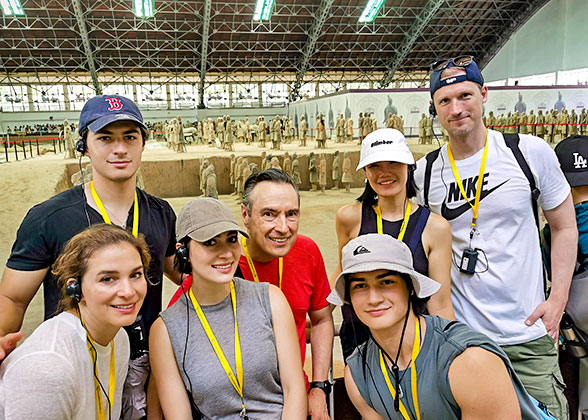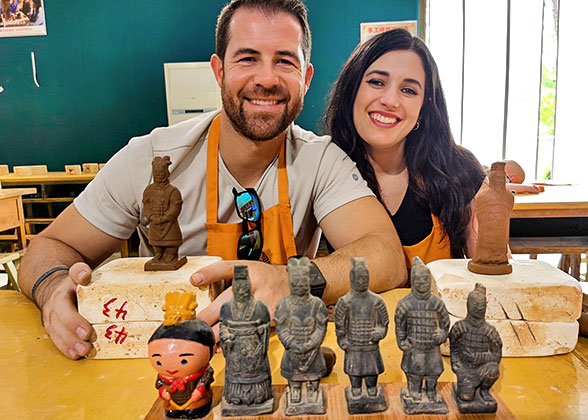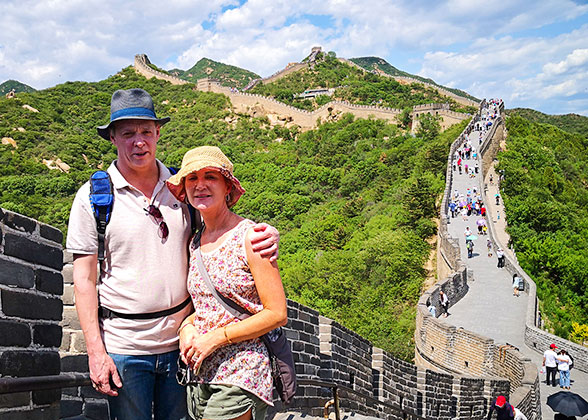Top 20 Questions about Terracotta Army
![]() The Terracotta Army is a large collection of life-sized terracotta figures buried in the mausoleum of Emperor Qin Shi Huang in Xi'an, China. Known as the "Eighth Wonder of the World," it features thousands of vivid terracotta soldiers, horses, and chariots, showcasing the mighty military power of the Qin Dynasty (221-207 BC).
The Terracotta Army is a large collection of life-sized terracotta figures buried in the mausoleum of Emperor Qin Shi Huang in Xi'an, China. Known as the "Eighth Wonder of the World," it features thousands of vivid terracotta soldiers, horses, and chariots, showcasing the mighty military power of the Qin Dynasty (221-207 BC).
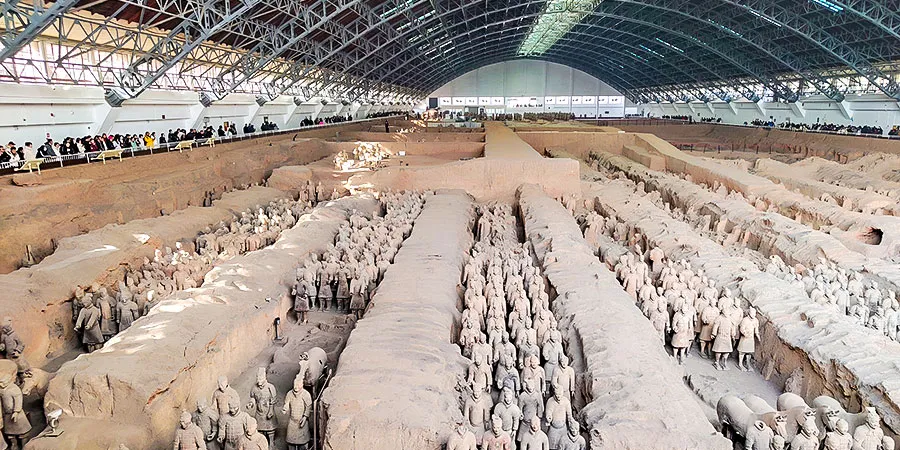 |
| Thousands of Terracotta Figures in Pit 1 |
![]() They are displayed in the three main pits of the Museum of Qin Terracotta Warriors and Horses, Lintong District, approximately a one-hour drive from downtown Xi'an.
They are displayed in the three main pits of the Museum of Qin Terracotta Warriors and Horses, Lintong District, approximately a one-hour drive from downtown Xi'an.
3. Who built the Terracotta Army?
![]() The Terracotta Army was designed and constructed under the supervision of the prime minister of the Qin Dynasty, acting on the orders of Emperor Qin Shi Huang, the first emperor of China. In detail, it was crafted by a workforce comprising both imperial workshop artisans and local civilian craftsmen.
The Terracotta Army was designed and constructed under the supervision of the prime minister of the Qin Dynasty, acting on the orders of Emperor Qin Shi Huang, the first emperor of China. In detail, it was crafted by a workforce comprising both imperial workshop artisans and local civilian craftsmen.
![]() The Terracotta Army is over 2,200 years old. Its construction began around 247 BC when Qin Shi Huang ascended the throne, and it took nearly 40 years to complete, ending around 208 BC.
The Terracotta Army is over 2,200 years old. Its construction began around 247 BC when Qin Shi Huang ascended the throne, and it took nearly 40 years to complete, ending around 208 BC.
![]() Influenced by the belief in the "immortality of the soul" and the idea of "treating the dead as if they were alive," Emperor Qin Shi Huang ordered the construction of the Terracotta Army to guard his tomb and resist enemies in the afterlife. It was meant to display the military strength of the Qin Dynasty and maintain his authority as emperor.
Influenced by the belief in the "immortality of the soul" and the idea of "treating the dead as if they were alive," Emperor Qin Shi Huang ordered the construction of the Terracotta Army to guard his tomb and resist enemies in the afterlife. It was meant to display the military strength of the Qin Dynasty and maintain his authority as emperor.
6. Who discovered the Terracotta Warriors first? And when?
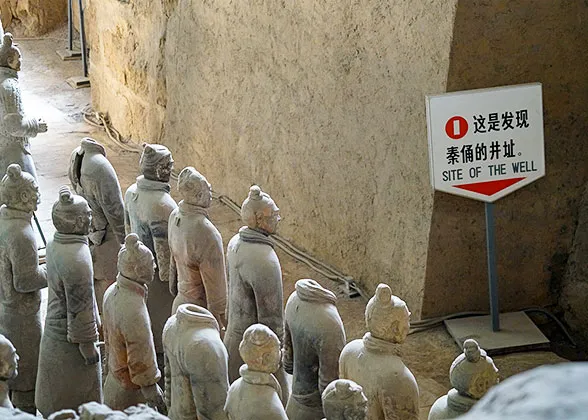 |
| Original Site of the Drill |
![]() In March 1974, villager Yang Zhifa and his fellows accidentally discovered some pottery fragments while digging a well in Lintong District. Archaeologists soon confirmed their significance, leading to the site's protection and the museum's establishment in 1975.
In March 1974, villager Yang Zhifa and his fellows accidentally discovered some pottery fragments while digging a well in Lintong District. Archaeologists soon confirmed their significance, leading to the site's protection and the museum's establishment in 1975.
![]() According to the latest statistics, more than 8,000 terracotta figures and horses of different types are laid out in three pits of the museum. Currently, over 2,000 terracotta figures and horses have been unearthed and are available for visitors to view.
According to the latest statistics, more than 8,000 terracotta figures and horses of different types are laid out in three pits of the museum. Currently, over 2,000 terracotta figures and horses have been unearthed and are available for visitors to view.
8. What types of Terracotta Warriors are there?
![]() The main types include infantry, cavalry, and charioteers. Among the infantry, the well-known ones refer to high-ranking officers, kneeling archers, and standing archers. Additionally, there are also acrobatic and civil official figures.
The main types include infantry, cavalry, and charioteers. Among the infantry, the well-known ones refer to high-ranking officers, kneeling archers, and standing archers. Additionally, there are also acrobatic and civil official figures.
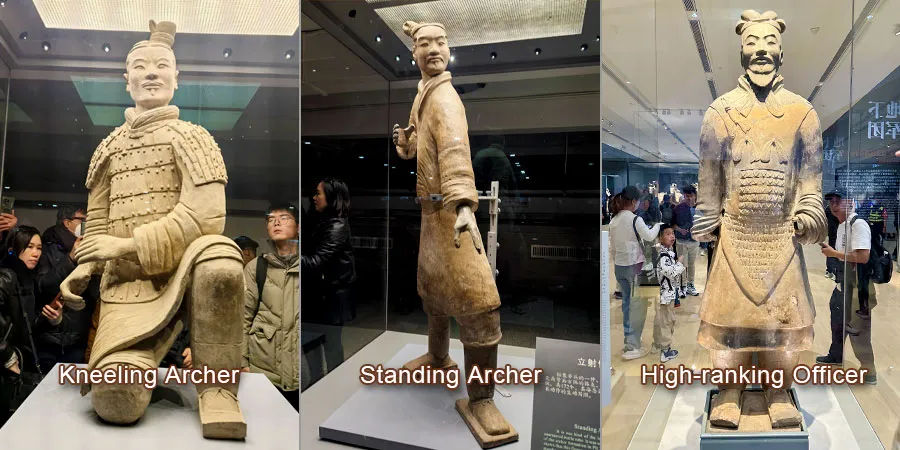 |
-
 There are 7 steps to complete an integrated pottery figurine: first, make its main body from the pedestal to the collar with yellow earth; then use the molds to make head, arms, and hands, next; assemble the parts and let them dry in the shade; carving the details and getting them fired in kilns are the following two steps. At last, after installing the head, add glaze and color to the Terracotta Warriors.
There are 7 steps to complete an integrated pottery figurine: first, make its main body from the pedestal to the collar with yellow earth; then use the molds to make head, arms, and hands, next; assemble the parts and let them dry in the shade; carving the details and getting them fired in kilns are the following two steps. At last, after installing the head, add glaze and color to the Terracotta Warriors.
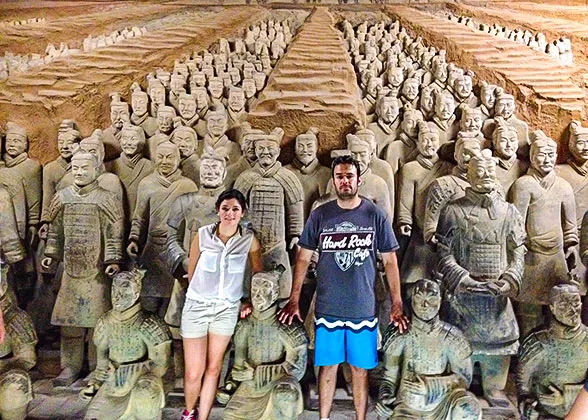
See Size of Terracotta Warriors from the Replica  Generally, they are life-size or a little taller. Specifically, they average 1.73 to 1.96 meters (5.68 to 6.43 feet), and the tallest one is around 2.5 meters (8.2 feet).
Generally, they are life-size or a little taller. Specifically, they average 1.73 to 1.96 meters (5.68 to 6.43 feet), and the tallest one is around 2.5 meters (8.2 feet).
11. How heavy are the Terracotta Warriors?
 The terracotta warriors vary in type and size. On average, each figure weighs around 180 kg (400 lbs). The heaviest are the terracotta horses, weighing over 300 kg (660 lbs). Among the terracotta figures, the heaviest high-ranking officer weighs about 250 kg (550 lbs) while the kneeling archers are the lightest, at approximately 100 kg (220 lbs).
The terracotta warriors vary in type and size. On average, each figure weighs around 180 kg (400 lbs). The heaviest are the terracotta horses, weighing over 300 kg (660 lbs). Among the terracotta figures, the heaviest high-ranking officer weighs about 250 kg (550 lbs) while the kneeling archers are the lightest, at approximately 100 kg (220 lbs).
12. Are all the Terracotta Warriors really different from each other?
 Yes, each warrior is unique. This is primarily because the Terracotta Army was created based on actual soldiers from the Qin dynasty. Each figure corresponds to a real individual, capturing distinct facial features, expressions, and personal details. Additionally, over 720,000 artisans and common laborers had been involved in the construction. They made some parts by hand, and even the parts made by molds would later be carved by hand for details, leading to the pottery figures being all different.
Yes, each warrior is unique. This is primarily because the Terracotta Army was created based on actual soldiers from the Qin dynasty. Each figure corresponds to a real individual, capturing distinct facial features, expressions, and personal details. Additionally, over 720,000 artisans and common laborers had been involved in the construction. They made some parts by hand, and even the parts made by molds would later be carved by hand for details, leading to the pottery figures being all different.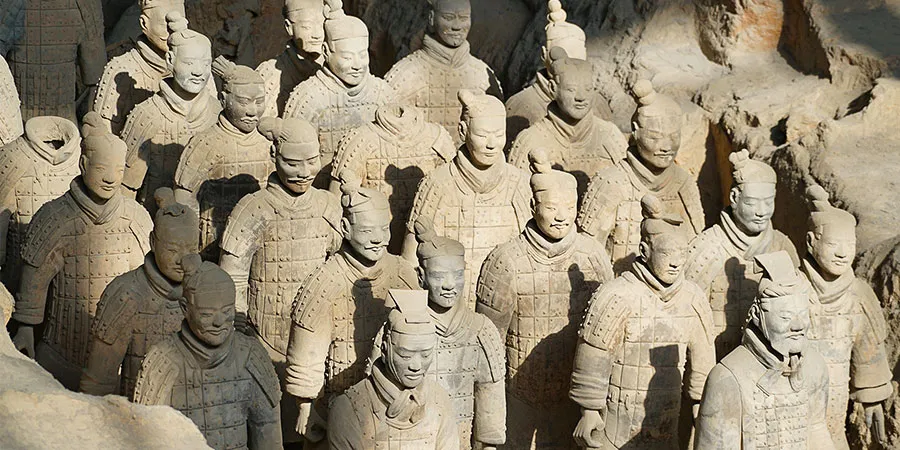
Terracotta Figures with Different Apperances
 See more about
See more about13. Are the Terracotta Army figures grey or colorful?
 They were originally painted in vibrant colors such as scarlet, pink, purplish red, dark blue, green, and reddish brown. However, due to long-term burial involving flooding, fire, and other damaging conditions, most of the pigments were already lost or damaged before excavation. Additionally, upon exposure to air, the surface paint layers rapidly flaked off and revealed a grey under layer, with current preservation techniques still being insufficient. Visitors can now see some of the colored figures, such as the green-faced soldier and the purple-sleeves figure, displayed in the museum's exhibition hall.
They were originally painted in vibrant colors such as scarlet, pink, purplish red, dark blue, green, and reddish brown. However, due to long-term burial involving flooding, fire, and other damaging conditions, most of the pigments were already lost or damaged before excavation. Additionally, upon exposure to air, the surface paint layers rapidly flaked off and revealed a grey under layer, with current preservation techniques still being insufficient. Visitors can now see some of the colored figures, such as the green-faced soldier and the purple-sleeves figure, displayed in the museum's exhibition hall.
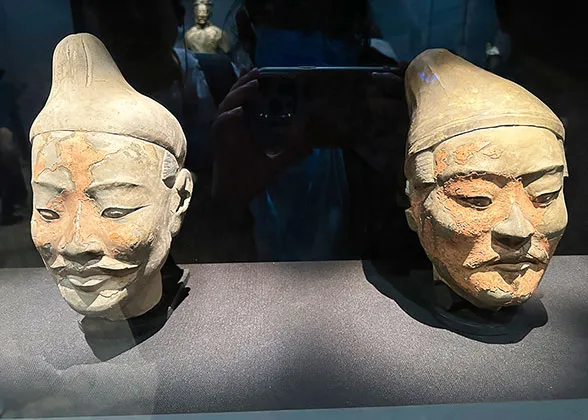
Color Painted Figure Heads 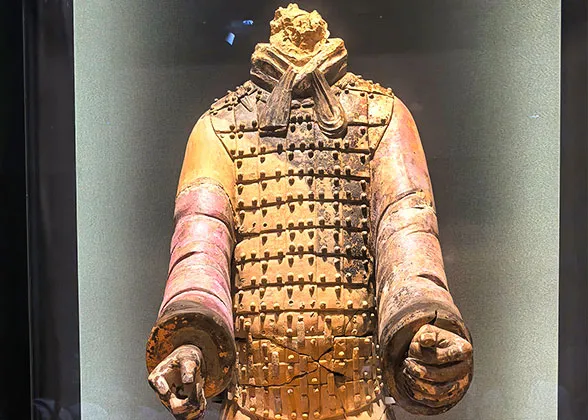
Terracotta Figure with Purple Sleeves  See more about True Colors of Terracotta Warriors
See more about True Colors of Terracotta Warriors
14. Is the Terracotta Army still being excavated?
 Yes, excavation is still ongoing. The displayed terracotta warrior figures represent only a small portion of the entire mausoleum. At present, the second excavation of Pit 2 and third excavation of Pit 1 of Terracotta Army are continuing steadily.
Yes, excavation is still ongoing. The displayed terracotta warrior figures represent only a small portion of the entire mausoleum. At present, the second excavation of Pit 2 and third excavation of Pit 1 of Terracotta Army are continuing steadily.
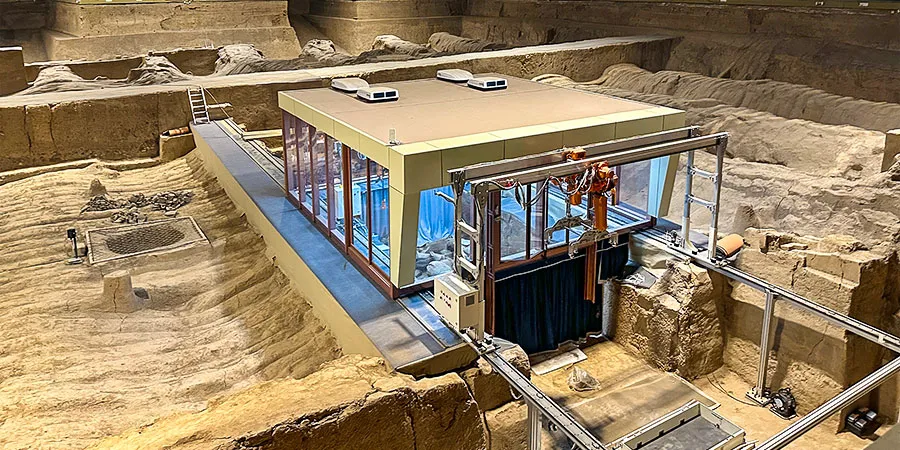
Onsite Excavation and Restoration in Pit 2  You can reach the Terracotta Army Museum from downtown Xi'an by metro, bus, taxi, or direct tourist bus. From Xi'an Xianyang International Airport, Xi'an North Railway Station, or Xi'an Railway Station, there are also convenient public transportation options. Most options take between one to two hours.
You can reach the Terracotta Army Museum from downtown Xi'an by metro, bus, taxi, or direct tourist bus. From Xi'an Xianyang International Airport, Xi'an North Railway Station, or Xi'an Railway Station, there are also convenient public transportation options. Most options take between one to two hours.
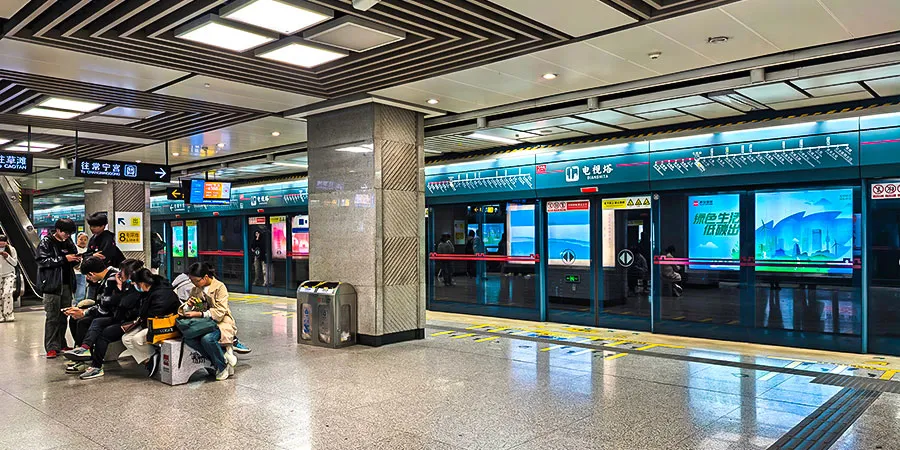
Xi'an Metro Station
 You may like: How to Get to Terracotta Army from Beijing/ Shanghai/ Hong Kong
You may like: How to Get to Terracotta Army from Beijing/ Shanghai/ Hong Kong
 The best time to visit is March to May and September to October on weekdays because of the pleasant weather and relatively fewer tourists. Optimal visiting hours are before 9:30 or after 16:00 to avoid crowds.
The best time to visit is March to May and September to October on weekdays because of the pleasant weather and relatively fewer tourists. Optimal visiting hours are before 9:30 or after 16:00 to avoid crowds.
17. How long does it take to visit the Terracotta Warriors?
 Generally, two to three hours are enough to visit the museum. If you prefer in-depth exploration, four to five hours may be required.
Generally, two to three hours are enough to visit the museum. If you prefer in-depth exploration, four to five hours may be required.
18. Is photography allowed?
 Yes, it is allowed. However, to preserve the terracotta figures, you should not use a flashlight during photography. In addition, for your safety and the protection of the figures, please do not cross the railings or enter the pits during your visit or while taking photos.
Yes, it is allowed. However, to preserve the terracotta figures, you should not use a flashlight during photography. In addition, for your safety and the protection of the figures, please do not cross the railings or enter the pits during your visit or while taking photos.
 Although a large number of helmets were unearthed in the stone armors and helmets pit, indicating that Qin soldiers were equipped with them, they often fought without helmets. One reason was to demonstrate their bravery and overawe enemies, reflecting the martial spirit of the Qin dynasty. Another reason was to reduce weight and increase agility in battle.
Although a large number of helmets were unearthed in the stone armors and helmets pit, indicating that Qin soldiers were equipped with them, they often fought without helmets. One reason was to demonstrate their bravery and overawe enemies, reflecting the martial spirit of the Qin dynasty. Another reason was to reduce weight and increase agility in battle.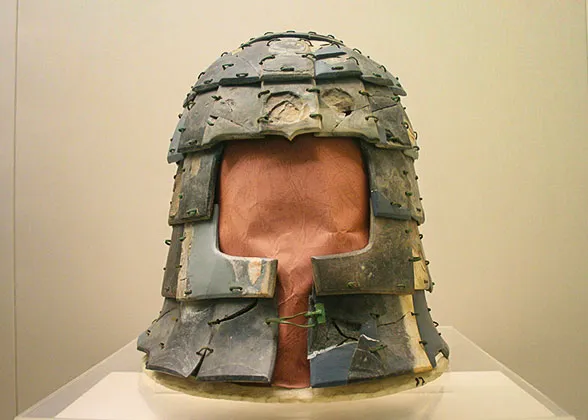
Unearthed Stone Helmet 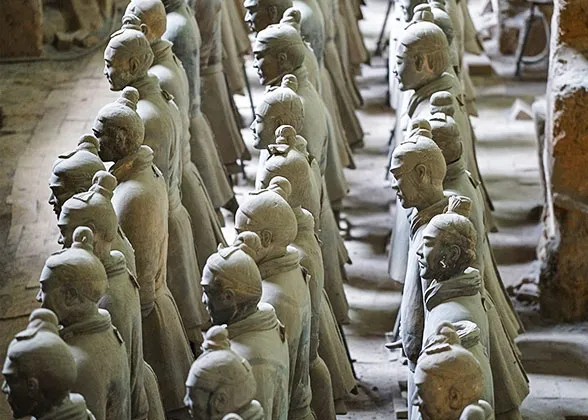
Terracotta Figure with Purple Sleeves 20. Is the Terracotta Army only found in Xi'an?
 No. While the Terracotta Army in Xi’an is the largest, other Chinese cities also have terracotta warriors. These include the Han Yang Ling Mausoleum and Yangjiawan terracotta warriors in Xianyang City, Shaanxi Province; the Shizishan terracotta warriors in Xuzhou City, Jiangsu Province; and the Weishan terracotta warriors in Jinan City, Shandong Province. In addition, Terracotta Warriors exhibitions are often shown around the world.
No. While the Terracotta Army in Xi’an is the largest, other Chinese cities also have terracotta warriors. These include the Han Yang Ling Mausoleum and Yangjiawan terracotta warriors in Xianyang City, Shaanxi Province; the Shizishan terracotta warriors in Xuzhou City, Jiangsu Province; and the Weishan terracotta warriors in Jinan City, Shandong Province. In addition, Terracotta Warriors exhibitions are often shown around the world.
 You may like:
You may like:
Overseas Exhibitions of Terracotta Army
4 Sites of Terracotta Warriors besides Xi'an Terracotta Army
